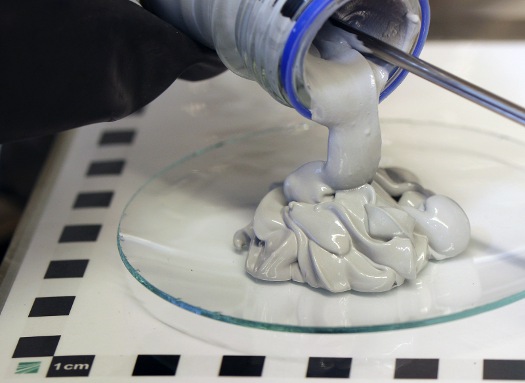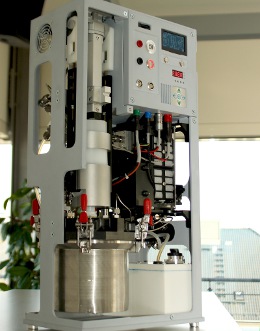 |
| June 01, 2021 | Volume 17 Issue 21 |
Designfax weekly eMagazine
Archives
Partners
Manufacturing Center
Product Spotlight
Modern Applications News
Metalworking Ideas For
Today's Job Shops
Tooling and Production
Strategies for large
metalworking plants
Can hydrogen paste power motorcycles and scooters?

POWERPASTE is a new, experimental hydrogen fuel source developed at the Fraunhofer Institute. [Credit: ©Fraunhofer IFAM]
High-pressure hydrogen fuel tanks are not a viable alternative-fuel option for motorcycles and scooters, but researchers in Germany have another plan: POWERPASTE. This material -- which sports a huge energy density -- stores hydrogen in a chemical form at atmospheric pressure and is activated simply by adding water.
The formulation of the new paste is based on magnesium hydride and was developed by a research team at the Fraunhofer Institute for Manufacturing Technology and Advanced Materials in Germany. Among the materials' many positive qualities is that it is easy to transport and replenish without the need for an expensive network of filling stations.
Gasoline and diesel engines powered by fossil fuels are being replaced by new propulsion systems. One fuel with big potential is hydrogen. Hydrogen vehicles are equipped with a reinforced tank that is fueled at a pressure of 700 bar. This tank feeds a fuel cell, which converts the hydrogen into electricity. This, in turn, drives an electric motor that propels the vehicle. The end products are heat and water.
In the case of passenger cars, this technology is well advanced, with several hundred hydrogen-powered automobiles already in operation on roads throughout the world. At the same time, the network of hydrogen stations is also growing -- albeit very slowly. In Germany, for example, the network is projected to grow from 100 to 400 stations over the next three years.
However, hydrogen is not currently an option for small vehicles such as electric scooters and motorcycles, since the pressure surge during refilling would be too great. Researchers at the Fraunhofer Institute wondered if the current designs for storage effectively shut out such vehicles from hydrogen technology. Could there be another way?

TRL 5 demonstrator of a power generator with a POWERPASTE cartridge and a 100-W PEM fuel cell. [Credit: ©Fraunhofer IFAM]
This was the inspiration to create POWERPASTE, which "stores hydrogen in a chemical form at room temperature and atmospheric pressure to be then released on demand," said Dr. Marcus Vogt, research associate at Fraunhofer IFAM.
Since POWERPASTE only begins to degrade at temperatures of around 250 C, it remains safe even when an e-scooter stands in the baking sun for hours. Moreover, refueling is extremely simple. Instead of heading to the filling station, riders just replace an empty cartridge with a new one and then refill a system partner tank with regular water.
The starting material for POWERPASTE is magnesium, a readily available raw material. Magnesium powder is combined with hydrogen to form magnesium hydride in a process conducted at 350 C and five to six times atmospheric pressure. An ester and a metal salt are then added in order to form the finished product.
Installed on a vehicle, the cartridge releases the POWERPASTE by means of a plunger. When water is added from an onboard tank, the ensuing reaction generates hydrogen gas in a quantity dynamically adjusted to the actual requirements of the fuel cell. Interestingly, only half of the hydrogen originates from the POWERPASTE; the rest comes from the added water.
"POWERPASTE has a huge energy storage density," said Vogt. "It is substantially higher than that of a 700-bar high-pressure tank, and compared to batteries, it has 10 times the energy storage density." This means that POWERPASTE offers a range comparable to -- or even greater than -- gasoline. It also provides a higher range than compressed hydrogen at a pressure of 700 bar.
What can this weird material power?
With its huge energy storage density, the developers think POWERPASTE is also an interesting option for some specialty cars, delivery vehicles, and even as range extenders in battery-powered electric vehicles (although that last option sounds clunky). It could also significantly extend the flight time of large drones, which could fly for several hours using the POWERPASTE energy material rather than a mere 20 minutes on an electric charge -- especially useful for survey work, such as the inspection of forestry or power lines. In another kind of application, campers could use POWERPASTE in a fuel cell to generate electricity to power a coffeemaker or toaster.
In addition to providing a high operating range, POWERPASTE has another point in its favor. Unlike gaseous hydrogen, it does not require a costly infrastructure. In places where there are no hydrogen stations, regular filling stations could sell POWERPASTE in cartridges or canisters instead.
The paste is fluid and pumpable. It could be supplied by a standard filling line, using relatively inexpensive equipment. Initially, filling stations could supply smaller quantities of POWERPASTE from a metal drum, for example, and then expand in line with demand. The capital expenditure for this setup would be quite low. By way of comparison, a filling station to pump hydrogen at high pressure currently costs a few million euros for each fuel pump. POWERPASTE is also cheap to transport. No costly high-pressure tanks are involved, and it doesn't require the use of extremely cold liquid hydrogen. The researchers have not addressed re-use of the cartridges or any residual materials left inside them once the canister is "empty."
The researchers think the new material really holds promise. Fraunhofer IFAM is currently building a production plant for POWERPASTE at the Fraunhofer Project Center for Energy Storage and Systems ZESS. Scheduled to go into operation later this year, this new facility will be able to produce up to 4 tons of POWERPASTE a year. They can test all types of vehicles then and also address key concerns such safety, flammability, any disposal issues, etc.
Source: Fraunhofer IFAM
Published June 2021
Rate this article
View our terms of use and privacy policy
